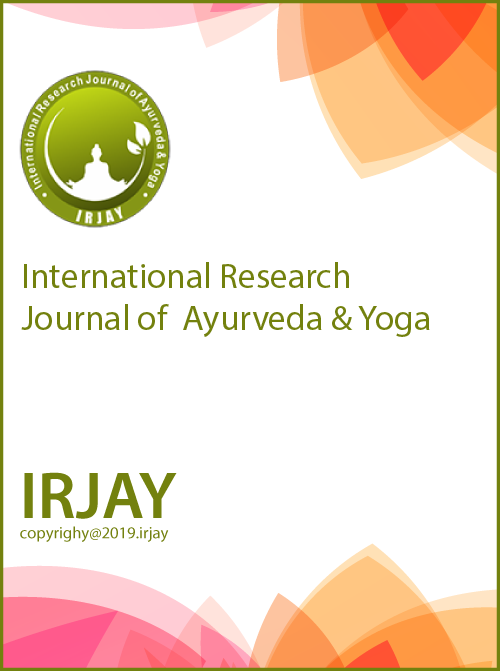Pharmaceutico – Evaluation of Pathyadi Varti Anjana Containing Moringa Oleifera Seeds: An Analytical Perspective
Keywords:
Anjana, Cataract, High-performance thin layer chromatography, Pathyadi Varti, PhytochemicalAbstract
Background: Blur vision, particularly due to cataracts, remains a significant global public health concern, especially in rural and underserved populations. Ayurvedic formulations such as Pathyadi Varti (PV), which comprises four potent herbo-mineral ingredients with psycho-physical Kaphahara properties, have shown promise in addressing age-related ocular degeneration. This study evaluates the physicochemical properties, organoleptic characteristics, and phytochemical composition of PV. Material and Methods: PV was prepared following classical Ayurvedic guidelines. Analytical evaluations included organoleptic and physicochemical assessments, qualitative phytochemical screening, and high-performance thin layer chromatography for the detection. Results: Results highlighted PV’s quality, stability, and therapeutic potential. Phytochemical screening revealed the presence of alkaloids, tannins, flavonoids, proteins/amino acids, and saponins. Conclusion: These findings underscore the potential of PV as a complementary therapeutic agent in cataract management. Its antioxidant properties, combined with the presence of key phytochemicals, suggest a role in mitigating oxidative stress, a key contributor to cataract formation. Integrating such formulations into modern therapeutic strategies may address unmet needs in managing age-related visual impairment. Vision is the most crucial human sense, utilizing over 30% of the brain’s processing capacity. Consequently, the fear of losing eyesight ranks among the top health-related anxieties.[1] Globally, cataracts are the leading cause of treatable blindness. In India, they account for blindness in approximately 0.73% of the population.[2] Research suggests that around 14.25% of older adults in India are affected by cataracts, with higher rates found among women and the elderly.
Downloads
References
1. Scott AW, Bressler NM, Ffolkes S, Wittenborn JS, Jorkasky J. Public attitudes about eye and vision health. JAMA Ophthalmol. 2016;134(10):1111-8. doi: 10.1001/jamaophthalmol.2016.2627
2. Wolde Kentayiso T, Alto AA, Abebaw Z, Misker D, Boynito WG. Cataract prevalence and its associated factors among adult people aged 40 years and above in south Ari district, southern Ethiopia. Adv Public Health. 2023;2023:1996608. doi: 10.1155/2023/1996608
3. Singh S, Pardhan S, Kulothungan V, Swaminathan G, Ravichandran JS, Ganesan S, Sharma T, Raman R. The prevalence and risk factors for cataract in rural and urban India. Indian J Ophthalmol. 2019;67(4):477-83. doi: 10.4103/ijo.IJO-1127-17
4. Sharma S. In: Kashinath Shastri P, editor. Rasa tarangini. 8th ed., Sloka no. 73-5. New Delhi: Motilal Banarasidas Publication; 2014. p. 534. 5. Sharma S. In: Kashinath Shastri P, editor. Rasa tarangini. 8th ed., Sloka no. 106-7. New Delhi: Motilal Banarasidas Publication; 2014. p. 540.
6. Anonymous. The ayurvedic pharmacopoeia of India (Formulations). 1st ed., Vol. 2-3., Part 2. New Delhi: Government of India, Ministry of Health and Family Welfare, The Controller of Publications; 2010. p. 104, 116, 159-180, 263.
7. Anonymous. The ayurvedic pharmacopoeia of India, Appendix-3, (3.3). 1st ed., Vol. 1., Part 2. New Delhi: Government of India,
Ministry of Health and Family Welfare; 2007. p. 191.
8. Anonymous. The Ayurvedic Pharmacopoeia of India, Appendix-2 (2.2.10). 1st ed., Vol. 1., Part 2. New Delhi: Government of India, Ministry of Health and Family Welfare; 2007. p. 141.
9. Anonymous. The ayurvedic pharmacopoeia of India, Appendix-2 (2.2.3). 1st ed., Vol. 1., Part 2. New Delhi: Government of India, Ministry of Health and Family Welfare; 2007. p. 140.
10. Anonymous. The ayurvedic pharmacopoeia of India, Appendix-2 (2.2.4). 1st ed., Vol. 1., Part 2. New Delhi: Government of India, Ministry of Health and Family Welfare; 2007. p. 140.
11. Anonymous. The ayurvedic pharmacopoeia of India, Appendix-2, (2.2.7). 1st ed., Vol. 1., Part 2. New Delhi: Government of India, Ministry of Health and Family Welfare; 2007. p. 141.
12. Anonymous. The ayurvedic pharmacopoeia of India, Appendix-2, (2.2.8). 1st ed., Vol. 1., Part 2. New Delhi: Government of India, Ministry of Health and Family Welfare; 2007. p. 141.
13. Anonymous, The ayurvedic pharmacopoeia of India, Appendix-2, (2.2.6- 2.2.7). 1st ed., Vol. 1., Part 2. New Delhi: Government of India, Ministry of Health and Family Welfare; 2007. p. 143.
14. Khandelwal KR. Practical pharmacognosy techniques and experiments. 16th ed. Pune: Nirali Prakashan; 2006. p. 149-56.


